
All categories
Featured selections
Trade Assurance
Buyer Central
Help Center
Get the app
Become a supplier

(2922 products available)




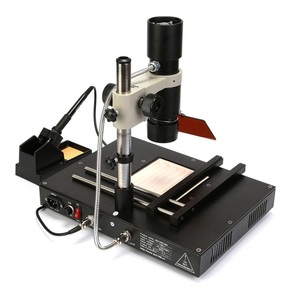
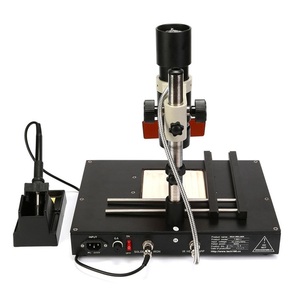
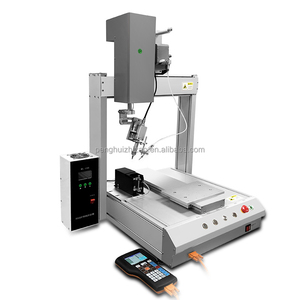







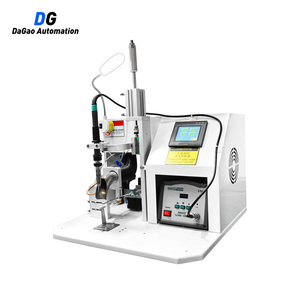


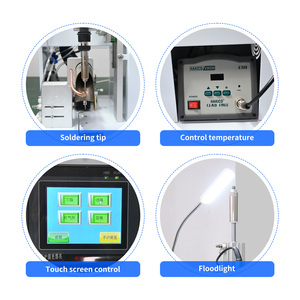





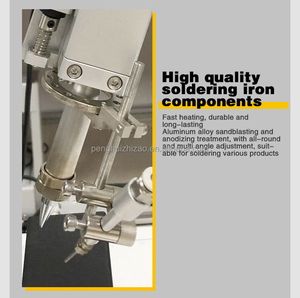














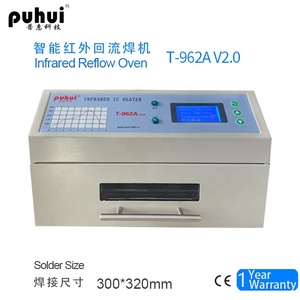






Infrared BGA rework stations are available in differing types, each tailored for specific applications and requirements. The following are the most common types, often dominating the market:
Manual Infrared BGA Rework Station
A IR rework station utilizes infrared heating for manual operation. It involves technicians using handheld tools to precisely control heat application. This type of rework station is generally ideal for small-scale operations or specialized tasks. Often, this model is prevalent in repair shops that handle the rework of individual components or small batches.
Automatic Infrared BGA Rework Station
BLGA rework stationsautomate most of the rework process. They feature automated component placements and programmable heating profiles. These profiles ensure consistent temperature control. This type of rework station is suitable for larger production environments. These offices have a high volume of PCB assemblies to be worked on.
Hybrid Infrared BGA Rework Station
A hybrid infrared BGA rework station combines manual and automated features. This model allows for flexibility in operations since basic tasks are automated. Yet, fine adjustments can be made manually when necessary. This type of rework station suits production lines that need some level of automation but also require occasional manual interventions.
Multizone Infrared BGA Rework Station
These infrared rework stations come equipped with multiple heating zones. This feature allows for precise temperature control across different areas of the PCB. Such a station is important for complex assemblies that need differential heating. Multizone stations are generally ideal for industries with high standards for quality such as aerospace or medical manufacturing.
Portable Infrared BGA Rework Station
This rework station utilizes infrared technology but is portable. Most people use it in field repairs or locations with limited resources. These stations, weighing less than their counterparts, can be easily transported. Still, they provide effective BGA rework solutions despite their size.
Telecommunications Industry
The telecommunications industry relies on complex PCBs found in smartphones, tablets, and other devices. It uses infrared BGA rework stations to repair bring and repair these intricate assemblies. These rework stations ensure that repairs adhere to stringent quality standards while decreasing the amount of time it takes for devices to be fixed.
Automotive Industry
Nowadays, automobiles come fitted with increasingly sophisticated electronics. This means PCBs in devices such as infotainment systems, sensors, and control units are all subject to BGA rework. Automotive production and repair facilities alike utilize infrared rework stations to keep production levels high while ensuring electronic components maintain their functionality.
Aerospace and Defense Industry
For the aerospace and defense industry, reliability and performance are critical since it holds all its operations accountable. PCBs under this industry are manufactured to operate under extremely harsh conditions. This means they must be of top-tier quality. The industry uses high-end infrared rework stations to fix complex multi-layer PCBs. This way the rework stations can safely support the unique needs of both circumstantial and high-end assemblies.
Consumer Electronics Industry
As stated earlier, the consumer electronics industry is one of the largest users of BGA rework stations. It is because intricate PCBs are ubiquitous in devices such as laptops, gaming consoles, and wearables. Infrared rework stations allow manufacturers to quickly fix defective boards and improve product quality, consumer satisfaction, and product quality.
Medical Device Industry
The medical device industry always prioritizes quality and dependability. It is the reason people find complex devices like diagnostic equipment, implants, and monitoring systems fitted with intricate PCBs. The infrared rework stations ensure that medical devices meet rigorous quality standards while minimizing device downtime.
Precise Temperature Control
Infrared BGA repair stationsgenerally offer accurate temperature regulation, which is essential for the rework process. PCBs can be damaged if they experience excessive or inadequate heat during the soldering of BGAs. A diverse selection of heating zones and high-precision thermostats aid in the seamless regulation of temperature. This ensures a steady temperature can be maintained throughout.
Multizone Heating System
Multizone heating is important when different areas of the PCB need differential heating to achieve optimal soldering results. Often, infrared BGA rework stations include several heating zones, each with its own temperature profile. This feature permits the simultaneous and independent heating of distinct regions. It caters to the heterogeneous requirements of assorted components on the same board.
Quick-Coupling Optics
The quick-coupling optics are key to an infrared BGA rework station since they focus the infrared energy on the target areas with pinpoint precision. With various lenses available, this feature enables users to switch between broad and tight focal areas effortlessly. It guarantees that heat is uniformly distributed over the BGA while shielding adjacent components from damage.
Vacuum Pick-and-Place System
The integrated pick-and-place system contributes to the station's effectiveness and efficiency. These systems use suction and vacuum to retrieve, transport, and install BGAs or Surface Mount Devices (SMDs) onto the PCBs. This feature guarantees accurate placement even in complex assemblies regardless of the skill level of the user.
Real-Time Monitoring and Feedback
Real-time feedback and monitoring systems are crucial for quality assurance. They allow users to track the temperatures and other vital factors in real time. These systems guarantee that the infrared rework process stays within the necessary limits. What’s more, they lower the margin for error and enhance the overall efficiency.
These are a few of the factors that will help one decide on the perfect infrared rework station for sale:
Precision and Control
The importance of precision and control cannot be understated when it comes to the rework of intricate electronic assemblies. It is the key element for any rework that clients may need. It is because infrared heating must be uniform and well-regulated. That is why it is critical to ensure users select a station with high-class temperature control and feedback mechanisms. They will enable the station to maintain the required temperatures throughout the process.
Component Compatibility
The rework stations come with varying specifications. That is why one must ensure their chosen BGA rework station is compatible with the components they plan to work with. It’s important to also consider the station’s capacity to manage different soldering profiles. Generally, this feature is vital for handling assorted components.
Ongoing Support and Maintenance
Infrared soldering stations are long-term investments that require support and maintenance over time. It is important to factor in the availability of spare parts, customer support, and documentation when selecting a station. A reliable manufacturer will support clients in all the maintenance tasks and prolong the station's life while ensuring optimal performance.
Budget Considerations
First, define the budget. Infrared rework stations vary widely in pricing and often depend on the type, features, and specifications they come with. It might be tempting to opt for the station that seems cheaper to cut costs at first. However, the decision should also factor in long-term performance and durability. The price should not be the only deciding factor since it will impact how effectively projects get completed in the long run.
Durability and Build Quality
One factor that cannot be ignored is the build quality of the infrared BGA rework station. What’s the use of a durable machine if it cannot withstand constant usage? Stations built from high-quality materials generally have a longer lifespan. This means there will be no constant need to go get repairs or replacements after the station wears out.
Regular Cleaning
The infrared rework station requires a clean workspace to function optimally. Dust, solder debris, and flux residue can affect the overall performance of the machine. That is why doing a regular clean will sort out these common culprits. Use soft brushes or vacuum systems to remove debris. Make sure never to utilize harsh chemicals since they may damage the station’s components.
Inspecting Heating Elements
One of the critical areas to focus on during maintenance is the heating elements. The infrared bulbs or emitters gradually degrade over time. This degradation directly affects heat distribution, thus resulting in poor soldering outcomes. Every so often, check for signs of wear or damage on these heating elements. The only option available when they have worn out will be to replace them with new ones so that the station can perform optimally once more.
Calibration of Temperature Sensors
Temperature control directly affects the station's performance and reliability of the reworked products. This is why regular calibration of temperature sensors is paramount. The station’s manual will provide the procedures for the calibration. In case it does not, one can consult professionals or watch videos online. Always ensure clients carry out calibrations using high-precision reference devices.
Check Mechanical Components
Infrared rework stations come with various mechanical features like arms, mounts, and positioning systems. These mechanical components are bound to wear out due to constant usage over time. So, it will be a good idea to inspect them regularly for any signs of damage or misalignment. It will ensure clients get to enjoy optimal performance, and it will also extend the life of its key mechanical components.
Software and Firmware Updates
Some advanced infrared BGA rework stations come equipped with software that controls their operations. Regular updates to this software are crucial to ensure the station is working as effectively as possible. Companies can benefit from added features or improvements in software that enhance the overall functionality of rework stations. Always check for software updates on the manufacturer’s website to avoid missing out on them.
Setting up the station requires following its specific setup instructions. It usually starts by securing the base station on a flat and stable surface, then connecting the power supply and heating elements, and finally calibrating the tools. Once the station itself has been set up, install the profile library to program each profile.
While some of the BGA rework stations are portable, it is generally not advisable to do the outdoor soldering. The weather and wind will impact the performance since the heat will not be evenly distributed. Furthermore, outdoor conditions can adversely affect the machine’s components.
They should consider the precision of temperature control and the multi-zone heating feature. Other factors to consider are component compatibility and real-time feedback/monitoring systems. Budget and durability are also key factors to help with the decision.
Remind clients to always wear protective gear to shield themselves from harmful fumes. They should also handle the components carefully and teach workers about the workings of the infrared emitters. It will ensure that no one gets harmed due to ignorance or messes with the emitters when trying to play around with them.
The thermocouple’s main purpose is to provide crucial feedback information on the temperature the machine is reading at that given moment. This information allows for optimal processing accuracy. The thermocouple directly affects how well the machine will perform and whether or not it will outperform temp highs and lows.